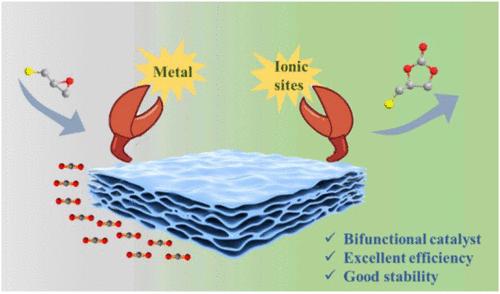Facile Synthesis of Bifunctional Heterogeneous Catalysts Used for the Chemical Fixation of a Low Concentration of CO2
IF 3.9
3区 工程技术
Q2 ENGINEERING, CHEMICAL
引用次数: 0
Abstract
Mounting concerns over climate change driven by anthropogenic greenhouse gas emissions have intensified demands for technologies that enable efficient conversion of CO2 into value-added chemicals. We report a bifunctional heterogeneous catalyst ZnBr2@PIL-VIm-Bpy, engineered through in situ metal coordination and radical polymerization, to co-anchor Lewis acidic ZnBr2-bipyridine complexes and nucleophilic imidazolium species within a porous ionic polymer matrix. Multimodal characterization (including solid-state NMR, XPS, FT-IR, etc.) verified the successful heterogenization of dual active sites in ZnBr2@PIL-VIm-Bpy. The obtained material exhibits excellent catalytic activity in CO2 cycloaddition reactions, and the conversion can reach 98.0% with a selectivity of 99.0% within 48 h at relatively mild conditions, comparable with those of homogeneous ionic liquids of VIm-Bpy and a binary catalytic system of ZnBr2+VIm-Bpy. The catalyst ZnBr2@PIL-VIm-Bpy can be easily separated from the product and can be reused at least 5 times without significant loss of catalytic activity, demonstrating excellent reusability and robustness. Especially, when the catalyst is applied to industrial flue gas conditions with low concentrations of CO2, a conversion of 85.5% can still be achieved in 96 h, which even surpasses the homogeneous catalysts of VIm-Bpy and ZnBr2+VIm-Bpy, confirming its outstanding catalytic performance in the elimination of low concentrations of CO2. This work establishes a heterogenization strategy combining enzymatic-like cooperativity with heterogeneous catalysts’ practicality, demonstrating particular promise for point-source carbon capture–utilization integration.

用于低浓度CO2化学固定的双功能多相催化剂的简易合成
对人为温室气体排放导致的气候变化的担忧日益加剧,这加大了对能够将二氧化碳有效转化为增值化学品的技术的需求。我们报道了一种双功能非均相催化剂ZnBr2@PIL-VIm-Bpy,通过原位金属配位和自由基聚合,在多孔离子聚合物基质中共同锚定Lewis酸性znbr2 -联吡啶配合物和亲核咪唑。多模态表征(包括固态NMR, XPS, FT-IR等)验证了ZnBr2@PIL-VIm-Bpy中双活性位点的成功异质化。所得材料在CO2环加成反应中表现出优异的催化活性,在相对温和的条件下,48 h内转化率可达98.0%,选择性达99.0%,与VIm-Bpy均相离子液体和ZnBr2+VIm-Bpy二元催化体系相当。催化剂ZnBr2@PIL-VIm-Bpy可以很容易地从产物中分离出来,并且可以重复使用至少5次而不显著损失催化活性,表现出优异的可重复使用性和鲁棒性。特别是将该催化剂应用于低浓度CO2的工业烟气条件下,96 h的转化率仍可达到85.5%,甚至超过了VIm-Bpy和ZnBr2+VIm-Bpy的均相催化剂,证实了其在低浓度CO2消除方面的卓越催化性能。这项工作建立了一种异质化策略,将酶样协同性与异质催化剂的实用性相结合,展示了点源碳捕获-利用一体化的特殊前景。
本文章由计算机程序翻译,如有差异,请以英文原文为准。
求助全文
约1分钟内获得全文
求助全文
来源期刊

Industrial & Engineering Chemistry Research
工程技术-工程:化工
CiteScore
7.40
自引率
7.10%
发文量
1467
审稿时长
2.8 months
期刊介绍:
ndustrial & Engineering Chemistry, with variations in title and format, has been published since 1909 by the American Chemical Society. Industrial & Engineering Chemistry Research is a weekly publication that reports industrial and academic research in the broad fields of applied chemistry and chemical engineering with special focus on fundamentals, processes, and products.
 求助内容:
求助内容: 应助结果提醒方式:
应助结果提醒方式:


